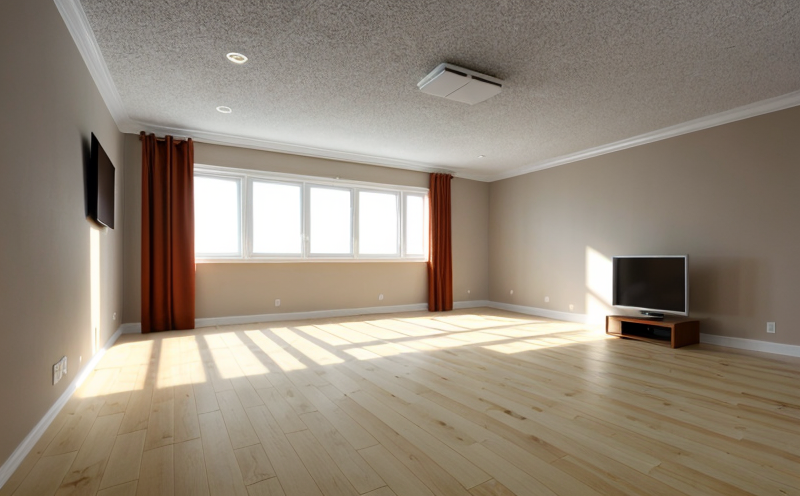ASTM E1414 Sound Insulation Testing of Building Partitions
The ASTM E1414 standard provides a method for measuring sound insulation in building partitions. This test is crucial in the design and construction phases to ensure that walls, floors, and ceilings meet specified levels of noise reduction between spaces. Compliance with this standard ensures that buildings are quieter, more comfortable, and more energy-efficient.
The ASTM E1414 test involves placing a sound source on one side of the partition and a receiver on the other side. The sound pressure level (SPL) is measured both before and after the sound source is activated. The difference between these levels gives an indication of the partition's ability to attenuate noise.
The testing process typically follows several key steps:
- Preparation: Specimens are prepared according to ASTM E1414 guidelines, ensuring they reflect real-world conditions as closely as possible.
- Setup: The partition is installed in a sound room with appropriate boundary conditions to minimize reflections and interference.
- Sampling: Sound pressure levels are recorded at various points on the receiving side of the partition.
- Data Analysis: The results are compared against specified thresholds, often derived from local building codes or industry standards.
The ASTM E1414 test is particularly important in commercial and residential buildings where noise pollution can significantly impact occupant comfort and well-being. By ensuring compliance with this standard, architects, engineers, and contractors can design spaces that are more acoustically efficient, reducing the need for costly retrofits later.
The results of ASTM E1414 testing play a critical role in the quality assurance process. They help ensure that buildings meet regulatory requirements and provide data that can inform future design decisions. For instance, if a partition fails to meet the specified sound insulation criteria, further design iterations or material changes may be necessary.
ASTM E1414 testing is widely recognized for its accuracy and consistency across different laboratories. This makes it an essential tool in the quality control of building materials and construction projects.
Why It Matters
The importance of sound insulation cannot be overstated, especially in densely populated areas where noise can significantly affect living and working environments. ASTM E1414 testing ensures that partitions effectively block out unwanted noise, contributing to a quieter indoor environment.
Noise pollution is linked to various health issues such as stress, sleep disturbance, and hearing damage. By adhering to standards like ASTM E1414, builders can contribute to healthier living conditions for occupants. Additionally, compliance with these standards demonstrates a commitment to sustainability and quality, enhancing the reputation of the builder or developer.
The test also supports energy efficiency by reducing the need for additional insulation in other areas of the building due to effective partitioning. This not only saves on construction costs but also helps reduce overall energy consumption.
ASTM E1414 testing is a requirement in many countries and regions, ensuring that buildings meet local standards and regulations. This standardization promotes consistency across international borders, making it easier for architects, engineers, and builders to work on projects across different jurisdictions.
Why Choose This Test
Selecting ASTM E1414 sound insulation testing offers several advantages over other methods or standards. The test is recognized internationally, ensuring that results are widely accepted and understood. This international acceptance simplifies compliance processes for builders working in multiple countries.
The method is highly reliable due to its standardized procedures, which minimize variability between different laboratories. This reliability ensures consistent quality across various projects and locations.
ASTM E1414 testing also provides detailed quantitative data that can be used to optimize building designs. By identifying specific areas where sound insulation can be improved, builders can make informed decisions about material selection and construction techniques.
The test is not only useful for new constructions but also for existing buildings undergoing renovations or upgrades. It helps ensure that any modifications do not compromise the sound insulation performance of the building.
Moreover, compliance with ASTM E1414 testing can reduce liability risks associated with noise complaints and lawsuits. By ensuring that partitions meet specified sound insulation criteria, builders can avoid legal issues and maintain good public relations.
International Acceptance and Recognition
- USA: ASTM E1414 is widely accepted in the United States as a standard for measuring sound insulation in buildings. It is often referenced in local building codes.
- Canada: The Canadian Standards Association (CSA) recognizes ASTM E1414, integrating it into its own standards and guidelines.
- Europe: While not specifically an EU standard, ASTM E1414 is widely recognized across Europe for its accuracy and reliability.
- Australia and New Zealand: These regions have adopted ASTM E1414 as a benchmark for sound insulation testing in buildings.
- Other Countries: Many countries around the world use ASTM E1414 as a reference standard, recognizing its robustness and reliability across different environments and climates.
The widespread acceptance of ASTM E1414 ensures that test results are universally understood and accepted. This international recognition simplifies compliance processes for builders working in multiple countries or regions.





